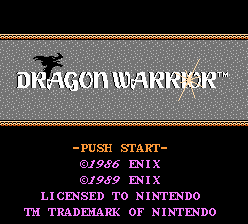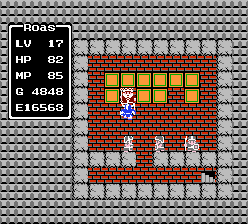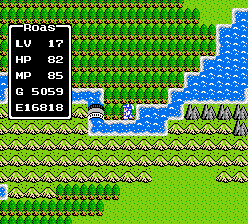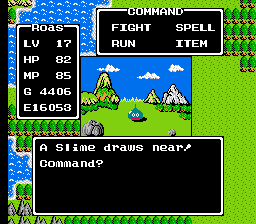Good morning and welcome to another edition of Games with Coffee! Let thy cup runneth full of beany goodness!
If the slight Olde English hasn’t tipped you off yet, today I’ll be talking about the very first RPG I’ve ever played: Dragon Warrior for the Nintendo Entertainment System! Also known as Dragon Quest in Japan, this is the first installment of the long running Dragon Quest series.
This game has many memories associated with it – every game I’ve played on the NES as a child was a challenge, but few have challenged me so like this one. But now I wonder, after almost 32 years since its original release and 29 years for the North American version, how does it fare in my eyes in the present day? Well, its the subject of today’s Espresso Shot Review! Let’s take a look:
Dragon Quest was released on May 1986 in Japan and in North America in August 1989 under the name Dragon Warrior, by Enix, a company producing RPG games before they merged with their rival, Squaresoft, in the early 2000’s to create Square-Enix. Dragon Warrior is considered to be one of the grandfather’s of Japanese RPG’s, setting the base template for all modern JRPG’s to follow.
I will be reviewing Dragon Warrior, released in August of 1989 for the NES, just over three years after Dragon Quest was released for the Famicom.

Story
Dragon Warrior takes place in the kingdom of Aelfgard, a series of modestly sized lands with rivers, islands and the like. Many years ago, when darkness covered the land, a hero named Erdrick brought peace to the kingdom by slaying a great evil and using an artifact called The Ball of Light to banish the remaining dark creatures. He handed it over to the King in Tantegel Castle, ensuring that the kingdom would be protected.
One individual was not a fan of the Ball’s radiance; he was the Dragonlord, a man corrupted by evil magic and who could control dragons. He gathered an army, invaded Tantegel Castle and stole the Ball of Light, casting the kingdom back into darkness. He then went on a reign of terror, razing towns and causing generic havoc before settling down in his castle, Charlock, on an island surrounded by impassable waters near Tantegel.
Years later, a prophet proclaimed that a new hero will emerge – a descendant of Erdrick himself – to save the land. After the Dragonlord kidnapped Tantegel’s beautiful princess, Gwaelin, a man (the player character) arrives at the kingdom, proclaiming himself to be that descendant. The current King, believing him, instructs him to save his daughter, defeat the Dragonlord and bring the light back to Aelfgard.

This is the hero of our story! His name is Roast.
As far as story goes, this is pretty cookie cutter: save the princess, defeat the bad guy, save the world. It was a common storyline at the time when the gaming industry was slowly transitioning to a more narrative structure as opposed to typical high score arcade fare. While common and accessible in its time, today, the storyline wouldn’t find as much traction, given that, in this writer’s opinion, older gamers yearn for more complex narratives. And yet, the simplicity of the story presented in Dragon Warrior makes this game a great, entry-level RPG for a child aged 7-10.
The most charming aspect of the story is the English translation’s use of Elizabethan (aka Olde) English. It gives the story and the dialogue a more Shakespearean, medieval tone and helps make the player feel like they’re in the middle of a fantasy world.
Gameplay
Dragon Warrior is a heavily text-based game. Every action, from talking to NPC’S, to searching for items and opening chests and to attacking and using spells, is controlled through several menu-driven options, accessed using the A button. Menu options include context specific actions like Talk, Search, Take and Door, along with traditional RPG staples like Item, Magic and Status. The interface was designed to be as simple as possible, given the limited number of inputs available to use.

On the field, opening the menu and selecting an action will execute that action in the direction the player character is facing. So, if you wanted to talk to someone or examine an object of interest, you’d have to face in that direction, otherwise you’ll get a notice saying no one is there. Also, to use the Door command, you’ll need Magic Keys. This is a bit irksome, since it would be easier to walk up to a door and press A to open it as opposed to opening the menu and selecting the Door command itself. Future installments, along with remakes, have addressed this, but it’s still a slight chore.
The field is separated into three types: Towns, the Overworld map and Dungeons. Towns are where you can obtain information for your quest from townspeople, buy items and gear and rest to recover HP and MP.
The Overworld is the area where most of the time is spent; players must travel to towns and dungeons to progress with the story. You’ll find random encounters with various monsters. Players will encounter stronger monsters or experience higher encounter rates depending on the terrain. An interesting thing about the hilly terrain is that there’s a slight pause as you walk across, making it feel like you’re actually crossing hills.

Bridges serve an additional purpose besides connecting landmasses, as players will see a clear difference in enemy strength once crossed. This invisible difficulty barrier helps players identify which areas to avoid until they get strong enough to go through without trouble.

In dungeons, players will encounter stronger monsters at an increased rate, but they will find rare weapons or items necessary to complete the game. Also, since these areas are shrouded in darkness, a torch or the Radiant spell are required to be able to see your surroundings.
When a monster is encountered, a different set of commands become available: Fight, Magic, Item and Run. Fight makes your character attack with an equipped weapon, with its effectiveness dependent on the players current strength and the weapon’s attack rating. Magic casts spells in your repertoire, like Heal and Hurt. Item allows the use of items in your inventory to use in battle and Run makes your character attempt to run away. You won’t be able to escape all the time; your success rate is based on how high your agility stat is. Upon wining the battle, you gain experience points and gold.
Regarding stats, they are easy to follow and keep track of. Besides HP and MP, strength, as mentioned above, relates to fighting prowess, defense is for taking monster attacks and agility indicates if you attack first before the opponent does, if you are able to strike without missing and if you are able to run away from the fight. Status effects are limited to falling asleep, being prevented from casting spells via Stopspell and being cursed by wearing cursed items; this is expanded in further installments. Compared to the intricacies and nuances of the modern RPG, with its various stats and ailments, Dragon Warrior simplifies it all, making it very accessible to newcomers.

At death, you get a message, saying “Thou art dead.”
If you die, either on the field or in battle, you return to the King with half your gold missing. It’s good in a sense, since you don’t lose progress in terms of leveling up, but if you’re trying to save up for the more expensive items for your quest, then you’re out of luck.
A few problems players could encounter are that the difficulty level ramps up quickly as you progress and that the only way to save is to return to Tantegel Castle and speak with the King. It’s wise to keep some Wyvern’s Wings with you, in case you’re knee deep in more difficult parts of the world, you’re out of magic and need to make a hasty retreat (or if you’re finished playing for the day and want to turn it off.). This archaic save mechanism continued to be a staple in later installments, (instead of speaking to a king, you’d confess in church), whereas other RPG’s settled for allowing players to save on the Overworld or save points within dungeons.
Another major problem is that, besides sleeping at an Inn or speaking to an wizard behind a desk at Tantegal Castle, there’s no way to recover spent MP. This makes conserving magic extremely important, as you can run out of it fairly quickly if you’re not careful.
Visuals
Legendary manga artist and creator of the Dragon Ball series, Akira Toriyama, lent his artistic talents to the Dragon Quest series. He created the artwork for characters as well as monsters, the most famous being the Slime creature, the mascot of the series.

It’s interesting to see how his art style influenced the series over the years, especially Dragon Quest VIII, my favourite of the series. But we’re talking about the very first game, so let’s segue on back…
Graphics-wise, the 8-bit style hasn’t aged well. Colours and textures are very simple and conservative in nature, but in the present day, they look very dated. The overworld sprites, emulating the Chibi art style, look cute and animated.



My biggest criticism has to be the dungeon design. It’s very bland in nature. Only when you reach the last area where the Dragonlord lies is there any difference in how dungeons look.
The biggest strength to the game’s visuals is the monster art. Toriyama’s art style ensures that the enemies silly appearances belies their terrifying strength.



Music
There’s very little music in the game, but some are quite memorable. One in particular is the title theme when you turn the game on. This title theme would go on to be used in all subsequent entries of Dragon Quest, making it a well-recognized theme.
I’m particularly fond of the overworld music. It gives off a medieval, I’m-crossing-the-land vibe and adds to the atmosphere.
What I found interesting is that the dungeon music drops in octaves as you descend deeper down the floors. It’s an unique approach to identifying which floor you’re occupying, since most times you have no idea which one you’re on in the first place. This has also carried on into later installments.
There are also a few jingles that either have carried over to future installments, like the music that plays when you level up or when an enemy is defeated, or stand out, like the death theme.
The rest of the music featured in game are simple and repetitive, yet pleasant to listen to.
Replayability
In terms of post game content, there really isn’t any. Once you finish the game, you finish the game. This was standard practice at the time for early JRPG games; it was not until the mid 90’s where, as an additional challenge, optional bosses could be fought for great rewards.
The few things one could do would be to either grind for experience to max your character’s levels or to try beating the game at a low level. Both are a slog. The hardest thing someone could accomplish, however, is to speedrun the game. Yes, you read that right; Dragon Warrior can be speedrun. Check out the video below as this runner for Games Done Quick manipulates the RNG to complete the game in less than half an hour! It’s insane!
Wrapup
As I mentioned at the start of the review, Dragon Warrior is one of the original RPG’s in which future JRPG’s modeled themselves after. Positives for the game include its story. which is easy to follow, the pleasant music, the excellent enemy art done by Akira Toriyama, and the accessible, if clunky at times, menu interface. Negatives include the dated graphics, the bland dungeon design, the odd game save mechanics and the steep difficulty curve, which may throw new players out for a loop.
Overall, Dragon Warrior is a fun retro game to play and an excellent way to pass time. I give it:

4/5






I went back and beat this game for the first time a couple of years ago. Dragon Quest is one of my favorite RPG series, so I felt like I needed to get the first title under my belt. If I ever get the chance to beat 2 and 3, I’ll have finished the whole numbered series (barring the MMO).
LikeLiked by 1 person
Nice! I really recommend 2, it’s a massive improvement to the first game. I’m not a fan of the structure of 3 though – I didn’t like the idea that you recruit your party from taverns, as opposed to having a set cast of characters. But hopefully you play through them and finish the series!! 😀
LikeLiked by 1 person
Yeah, I prefer a set cast as well – IX does the tavern recruitment thing and having a generic cast of player-designed allies alongside a blank slate player character makes it more difficult to get invested in the story of the game.
LikeLiked by 1 person
I will never forget the first time I crossed a bridge and ran into a wyvern and was murdered a short time later. This game is awesome! I once played very far into it and thought I could pick it up again but had no idea where I’d left off. Starting over again and re-grinding was not feeling good to me, so I put it down again. One of these days I’ll finally finish it. Maybe I’ll try the Game Boy Colour remake for a fresh change.
LikeLiked by 1 person
Oooh… I remember that feeling too! Wyvern’s may look funny, but man, are they dangerous!
I remember playing the GBC version some time ago, there’s a big difference graphically and gameplay wise. You should check it out if you get a chance and finally beat it! You can do it!!!
LikeLiked by 1 person